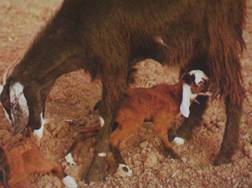 |
||||||||
| Major Activities |
Live Stock :: Goat :: Disease Management & Vaccination Schdule |
|||||||
GOAT POX Goat-pox is not of uncommon occurrence, but it is less severe than the sheep-pox. The nature of the disease is similar to that of pox in sheep. The incubation period varies from 5 to 10 days. The disease tends to attack male kids and ewes in milk. Initially there may be slight pyrexia. The lesions are not so side spread as in sheep-pox, being confined to the hairless regions of the body such as axilla, things, nose and mouth. In the female the udder may also be involved. The lesions are typically of pox but usually are much smaller than those of the sheep-pox. The goat-pox virus is antigenically distinct from the sheep pox virus, although it is transmissible experimentally to both goats and sheep. The goat-pox in sheep is more severe than the sheep-pox. The goat-pox virus is anitgenically distinct from the sheep pox virus, although it is transmissible experimentally the sheep-pox. The lesions occur on the lips and oral mucosa, the teats and udder. The goat-pox virus affords solid protection in sheep against both goat-and sheep-pox, but the sheep-pox virus does not protect goats against the goat pox. (Source: Dr.Acharya, Handbook of Animal Husbandry) |
||||||||
Technologies |
||||||||
Veterinary Services |
||||||||
Disease Management
Other Preventive Measures
Preventive Measures we do not take
Problems in pregnancy
Pregnancy ToxemiaThis is a problem in the late pregnancy, normally the last month and especially last two weeks. It is normally related to a doe with multiple kids. During the last two months, the kids are adding 70% of their birthing weight. During the final weeks, there is additional nutritional requirements for the kids as continue to increase in size and there is less and less room for the rumen to hold the same amount of food. The goats body will give the kids nutritional needs the priority at the expense to the mother. She may not be able to consume enough nutrition and the body will start converting the mothers carbohydrates stored in her tissues. This leads to the release of keton bodies into her blood - a sign that her metabolism is faulty. The symptoms will be a loss of appetite, not wanting to get up or move around, sweet-smelling breath, limping and swelling of feet or walking very tenderly. Ketosis strips can be used to identify if the doe is ketotic Give doe propylene glycol twice a day. We give 60cc drench in am and pm. We also create a mixture of sodium bicarbonate with water and give 30cc drench am and pm. Help get the doe up and moving around during the day and offering her high energy food. AbortionsNutritional ProblemsProper nutrition is essential for having healthy kids. Simultaneous deficiencies of energy and protein can cause abortion of embryos early in the pregnancy. Deficiencies of some trace minerals such as copper and iodine can be the cause of abortions. Also, excessive selenium for an extended period can cause abortions. Infectious ProblemsAn abortion by one or more of the goats in your herd may indicate an infectious disease that needs an overall management response. It is likely that your vet will be required to identify the type of infection causing the problem.
|
||||||||
BRUCELLOSIS OF GOATS
|
||||||||
Transmission A large number of organisms are eliminated ruing abortion. The mode of entry is by ingestion or via conjunctiva. The aborted foetus, vaginal discharge and milk from infected goats contain a large number or organisms. Symptoms In infected goats and sheep state of abortion may occur followed by a quiescent period during which a few abortions occur. The aborted animals do not breed. After 2 years or more another abortion storm is likely to occur.
|
||||||||
Diagnosis, Treatment and Control It is not possible to diagnose brucellosis on the basis of symptoms alone. The suspicion is aroused when humans in contact suffer from undulant fever and there is poor breeding record in goat herd and evidence of mastitis. The diagnosis can be done by the isolation of organisms and by serological tests. This is based on hygiene, vaccination, testing and disposal. Good management practice is essential. Separate quarters should be provided for kidding. Immunization can be done with attenuated as well as killed vaccines. The test and disposal procedure is highly desirable. JOHNE`S DISEASE Johne`s disease is a specific chronic contagious enteritis of cattle, sheep, goat, buffaloes and occasionally of pigs. The disease is characterized by progressive emaciation, and in cattle and buffaloes by chronic diarrhea and thickening of the intestine. Transmission Under natural conditions the disease spread by ingestion of feed and water contaminated by the faeces of infected animals. The infection occurs mostly in the early month of life. The incubation period extends from 12 months to several years. The animal aged 3 to 6 years mostly suffer from the disease. Affected animals may not show clinical symptoms continue to discharge organisms in faeces. The organisms persist in pastures for about 1 year. The organisms are susceptible to sunlight, drying and high PH of soil; continuous contact of urine with faeces reduces the life of bacteria. In cattle clinical signs appear mainly during 2-6 years of age. The infected animals which are apparently healthy, often show clinical signs after parturition. |
||||||||
| Home | Success Stories | Publication | Gallery | Forms | FAQs | Related Links | Contact | |
||||||||
| © All Rights Reserved. TNAU-2008. |
||||||||

